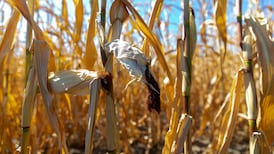The omens are not good for the future of the hen harrier in Ireland if the launch of a new programme to save them is anything to go by.
Lashing rain accompanied the launch of the hen harrier threat response plan by the Minister of State for Nature, Heritage and Electoral Reform Malcolm Noonan in a place called The Cut in the Slieve Bloom mountains in Co Laois.
So called because the road cuts through dense, high hedges on both sides, this is a scenic part of the Slieve Bloom mountains and was designated as a special protection area (SPAs) in 2012 for the hen harrier, one of Ireland’s most cherished and rare birds of prey.
During nesting season it is possible to get a rare sight of these magnificent birds, known as the skydancer, but visibility was obscured by thick cloud and rain.
READ MORE
National Wildlife and Parks Service regional officer Ciara O’Mahony said 218 square kilometres of the Slieve Bloom mountains area was designated as a SPA for the hen harrier, yet the numbers have continued to decline. The fledging rate locally is far below the replacement rate for the birds and demands “urgent and immediate attention”, she warned.
Within the Slieve Bloom SPA, 23 square kilometres has been given over to blanket bog to protect the hen harrier, but it will not be enough on its own.
Mr Noonan warned that the situation for Ireland’s endangered birds is “stark. This beautiful bird of prey could disappear in my lifetime and in yours if this trend continues. That would be an awful legacy for us all. Collective action is required if we are going to have any meaningful and long-lasting impact.”
NPWS director of scientific advice and research Dr Andy Bleasdale sounded a slightly more optimistic note stating that drone footage had been successful in pinpointing the nesting locations for the hen harrier. This will allow for more targeted actions to ensure that their habitats are not disturbed possibly including land abandonment and deforestation.
The fact that there had been more than 2,400 submissions to a Government consultation on the bird’s future indicates they are a “flagship species” in the national conscience, he suggested.
The hen harrier population has been monitored in the Republic since 1998. The latest survey, which was carried out in 2022, reveal that numbers declined by almost a third between 2015 and 2022.
The 2015 survey found between 108 and 157 pairs in the Republic of Ireland with the breeding population now estimated to be between 85 and 106 pairs. That represents a 59 per cent decrease since the first national survey was taken in 1998-2000.
[ Plight of hen harrier pits nature against climate policiesOpens in new window ]
The hen harrier threat response plan envisages financial incentives for landowners who farm the land within hen harrier SPAs.
The threat plan has been criticised by the Environmental Pillar as a “roadmap without a clear destination”. The Pillar, which includes organisations such as Birdwatch Ireland and An Taisce, said the plan identifies that afforestation of upland areas is the main threat, but does not set out clear targets to deal with it. The onus is on Coillte, the Pillar said, to cease reforestation of its plantations while restoring its afforested peatlands.
- Sign up for push alerts and have the best news, analysis and comment delivered directly to your phone
- Join The Irish Times on WhatsApp and stay up to date
- Listen to our Inside Politics podcast for the best political chat and analysis




